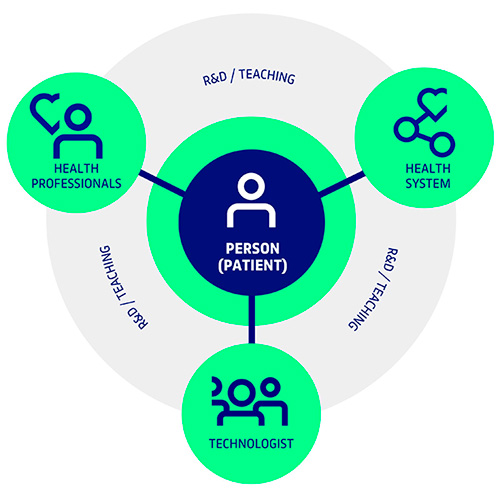The current coronavirus disease (COVID-19) is collapsing hospitals all around the world. But it’s also collapsing all kinds of emergency response support systems. Emergency phone numbers have easily tripled the number of calls they get these days. Many of them asking for relatively simple advice on symptoms and procedures related to the coronavirus, complicating the triage of people that do require urgent treatment. Not the best time to have a heart attack!.
Unsurprisingly, chatbots, voicebots and all kinds of conversational assistants quickly come to mind as a way to flatten the emergency phone curve. Indeed, we have recently seen many Covid chatbots popping up: in Italy, India, in Spanish-speaking countries, from Microsoft and even from the own World Health Organization, to name a few. Their goal is to stop the spread of misinformation, help with self-diagnosis and give prevention advice. They are a clear example of the current trend in eHealth and telemedicine.

eHealth model (from the eHealth Center at UOC)
And given that the current pandemic has taken all us by surprise, I think the bot community has done a great job in quickly providing some solutions. Unfortunately, I don’t expect any of them to have any significant impact in reducing the load of the emergency services. Let’s see our five conditions and five recommendations for building an impactful Covid bot.
Five conditions for a useful Coronavirus chatbot
It must have voice support. The virus is especially concerning for seniors. And many of them still prefer a traditional voice interaction over texting in WhatsApp. Or they may just have some physical limitations that prevent them from a quick use of chat windows or mobile devices.
It must be integrated into the official health system. If we want to free emergency phone numbers, the best way to do it is by letting some of the calls to those numbers be managed by the bot that would then take care of the easy questions and redirect back to humans otherwise. Even if only a small percentage of the calls can be covered by the bot (e.g. a 30%) that would be already a huge relief during these peak weeks. The bot could also be useful to collect anonymous epidemiology data to report back to the health authorities and help them make more informed decisions.
It must be continuously updated. What we know about the virus changes every day. And with it, the recommendations to the population (in terms of cleaning strategies, social distance, self-diagnosis,…). A chatbot that it’s not continuously updated with this info could cause more harm than good.
It must be adapted to the local regulations. Every country has its own specific advice and regulations. Generic chatbots can only be useful for a limited number of questions on the nature and symptoms of the virus but any effective recommendation must be linked to local, provincial and state instructions.
It must cover confinement rules. Many of the questions citizens have are not so much related to the virus itself but to the things they can/cannot do (can I walk the dog? can I go out with my kids?,…). A Covid chatbot needs to know about policy regulations as much as health aspects.
Five recommendations to build a useful Covid chatbot
The above criteria already drive key design decisions on the chatbot (e.g. being a voice bot, integrating with the local/national call centers…), but I’d like to briefly point out some additional important characteristics.
It should be transparent/open source. Given the impact of the chatbot, I think the design of the chatbot should be as transparent as possible so that everybody could take a look at it. Other eHealth applications have been largely controversial after it was discovered they were storing users data or turned to be just very poor implementations that had cost millions of taxpayers money. If we want to instill trust in the chatbot one way to do it is by being very open about how it’s been built. Even better if the chatbot platform itself is open source, as ours. This transparency will also enable the creation of a community around the bot that could send suggestions or contribute improvements. And even agree on a core bot definition to be shared and reused by others to avoid starting from scratch every single time.
It should empathize with the users. Many chatbots already offer some type of sentiment analysis that helps them show some empathy. But in this pandemic context, this is especially important as many people will call with clear signs of anxiety and stress. The bot needs to be trained to recognize those feelings and react accordingly. The bot’s goal is not just to provide information but to reassure people. A dose of behavioral design would be also useful here.
It should be constantly supervised. Monitoring is always a key part of any chatbot development project as the client can’t fully foresee what the visitors will ask the bot (or how they will express those questions). Given that many of the things our society is experiencing these days (like the confinement) are new to most of us, it’s even more difficult to predict what questions worry our citizens the most. Monitoring how people use the chatbot will shed some light on the most common concerns and will allow us to quickly react to them by adding new intents and training sets to the bot.
It should be built by an interdisciplinary team. I don’t believe this bot can be built by chatbot experts alone. It requires medical expertise, psychological knowledge, and government policy experts to make sure the chatbot recommendations are appropriate.
It should be treated as a safety-critical system. Many of the recommendations above could be ignored if the chatbot could be wrong from time to time. But being wrong could be the difference between life and death. Same as we tolerate our office software crashing from time to time but a software glitch in a plane flight control system cannot be tolerated as it will likely cause some tragic accidents. In engineering, we call safety-critical systems to those systems whose failure could result in loss of life, significant property damage or damage to the environment. Safety-critical systems are typically subjected to more restrictive regulations and formal tests and certification procedures. I believe a pandemic chatbot should be considered as such. This also involves security aspects (e.g. to prevent unauthorized access to the bot data or DDoS attacks to bring down the bot).
Bonus recommendations: Data import tools adapted to the medical domain (e.g. able to “read” public websites, WHO FAQs or other types of medical protocols and bootstrap the bot definition), multi-channel support (to reach the users where they are) and independence of the NLU provider (to facilitate migrating from one to another; important for some languages that may not be supported by all providers) are other important aspects to take into account.
Chatbots for future pandemics
Clearly, an effective pandemic chatbot is by no means an easy task. As such, I’m not sure we can build one in time to solve any of the current Covid crisis. But I do believe that we should start preparing and researching what procedures, infrastructure, and methodological aspects need to be developed to be prepared to manage the post-crisis and ready for when the next one comes.
Featured Image by Sumanley xulx from Pixabay



I find the post very interesting and well explained.
thank you